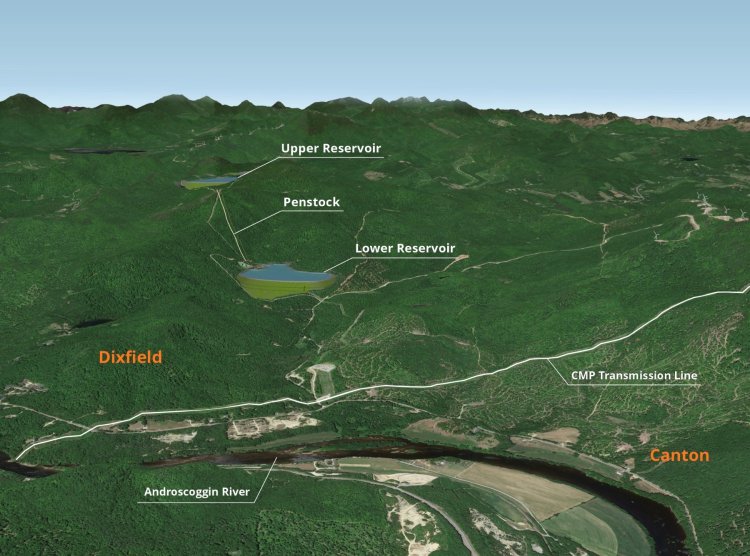
DIXFIELD — Representatives from a company developing a $1 billion pumped storage hydropower project in Oxford County met Aug. 11 with the Select Board.
“One thing to understand is that this is a long process … about four or five years” said Tom Brennan, public affairs director with Western Maine Energy Storage. “It’s going to be regulated by (the Federal Energy Regulatory Commission).”
The project would be the first of its kind in Maine and among the largest in the Northeast, capable of generating about 500 megawatts of on-demand power. The project would use two 100-acre artificial reservoirs to store and release water for electricity generation during peak demand.
According to the application to federal regulators, the developer estimates annual energy output at 1 million megawatt hours; for reference, Maine uses a little more than 11 million megawatt hours of electricity a year.
Western Maine Energy Storage was established in May 2024 and operating out of Cianbro Corp.’s Pittsfield headquarters. It submitted its application for a preliminary permit to federal regulators July 21.
Brennan was joined at the meeting by Lauren Walsh, Cianbro’s environmental manager, and Tom Saviello, a professional forester and former Maine state legislator.
Brennan said Walsh is guiding the permitting process. “There’s going to lots be of opportunity to come back and talk to you folks,” he said. “We’re right at the very beginning of this. The preliminary application was just submitted.”
The project is slated to be located off Ludden Lane, which is off the Canton Point Road, in a relatively undeveloped area.
Walsh noted it’s near the Central Maine Power transmission corridor, “one of the reasons for the selection of this site.”
Walsh said that as it stands, the whole project is sited in Dixfield, except for a small corner in Canton.

“The essence of this project really is to construct a water battery,” Brennan told the board Monday. “And the way it works is you have a water reservoir at a higher elevation than the second reservoir, which is at a lower elevation. … we have all these renewables that are functioning now, but the thing is, the sun doesn’t shine all the time and the wind doesn’t blow all the time.
“So when you have plentiful power and the rates are fairly cheap, you pump water up, and when it’s costly and the grid is strained, you let it flow back down through turbine and put that power to generate back into the grid and fill the gap.”
Brennan noted that this is not new technology. “It really started in Switzerland in the 1890s,” he said. “But there are about two dozen of the facilities around North America; none in Maine but there are two in western Massachusetts. So they’ve been time tested.”
Walsh said each reservoir is roughly 100 acres. “The entire project footprint that we’re proposing is roughly 625 to 630 acres.”
Asked who will own the station once complete, Walsh said Cianbro is developing it. “It’s a big project, so we don’t expect we’ll be the only owner. There will be investors.”
Board member Laurie Woodhead asked, “Who gets the benefit from this? Where does this go?”
Brennan responded, “It will go into the grid and it will stabilize the flow of electricity basically, and the resilience of the grid.
“A couple of winters ago, we had a bunch of storms and our power supply was impacted. A facility like this would be able to level things off and pick up the slack. I think it benefits everybody.”
Walsh said they’re early in the permitting phase, so the preliminary permitting application generally outlines the location for the project, and through FERC process, “we will go through several studies benefits the environmental impact, finalizing the location for those reservoirs. That permitting process will take anywhere from three to five years.”
Brennan noted, “We’d love to pursue constructing one of these facilities here in western Maine.”

We invite you to add your comments. We encourage a thoughtful exchange of ideas and information on this website. By joining the conversation, you are agreeing to our commenting policy and terms of use. More information is found on our FAQs. You can modify your screen name here.
Comments are managed by our staff during regular business hours Monday through Friday as well as limited hours on Saturday and Sunday. Comments held for moderation outside of those hours may take longer to approve.
Join the Conversation
Please sign into your CentralMaine.com account to participate in conversations below. If you do not have an account, you can register or subscribe. Questions? Please see our FAQs.